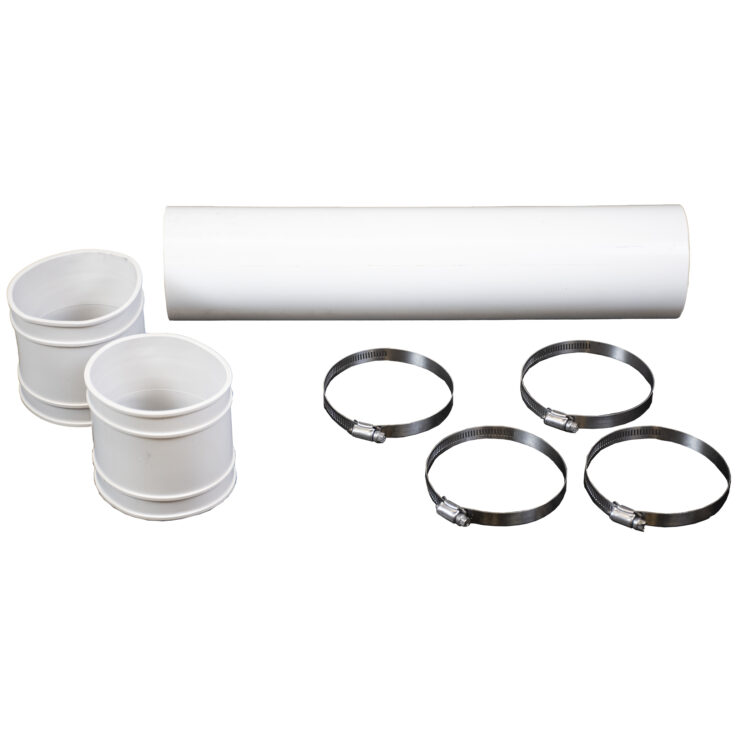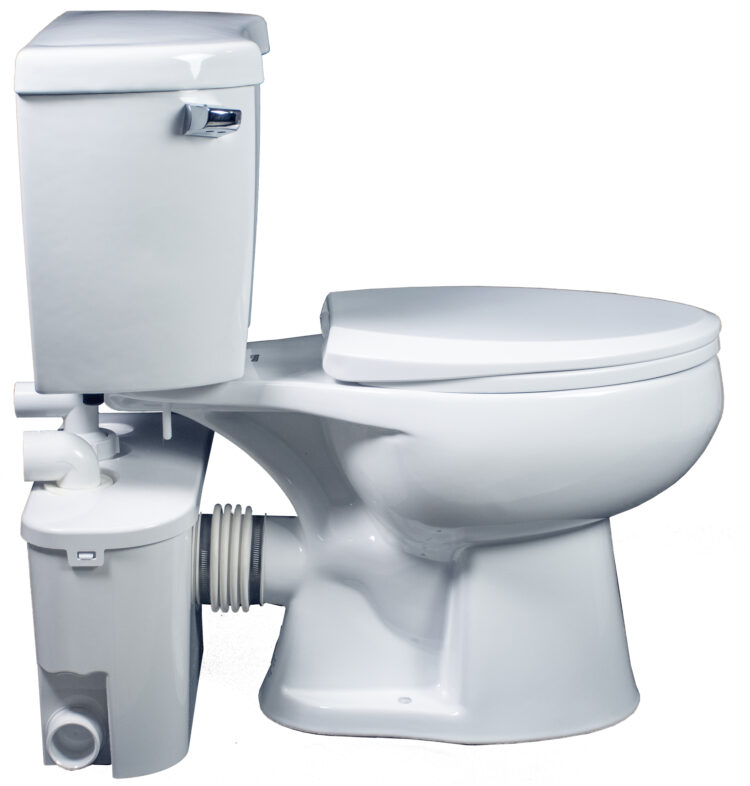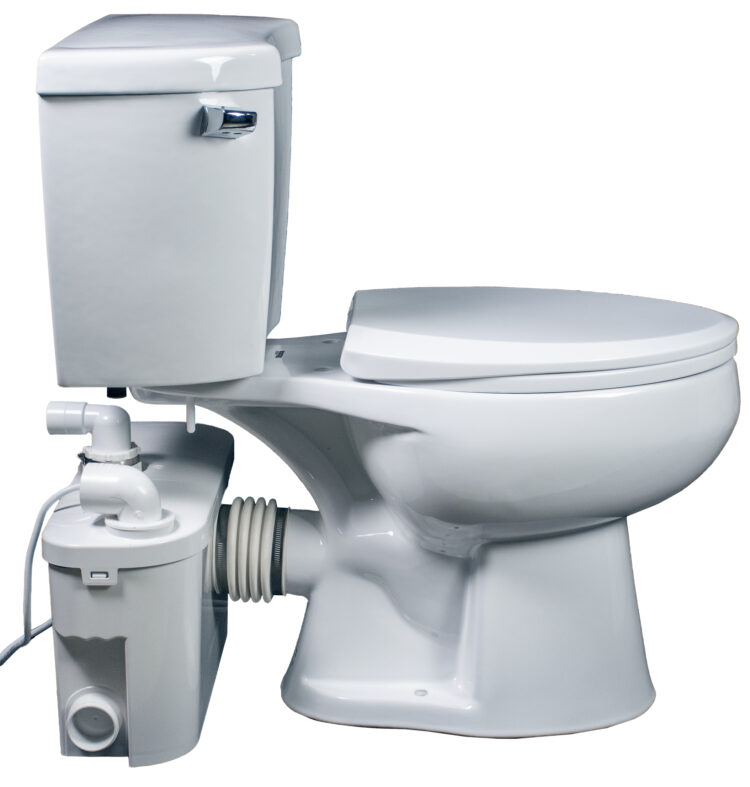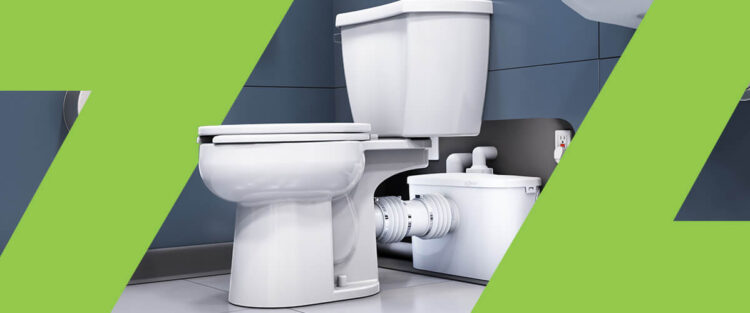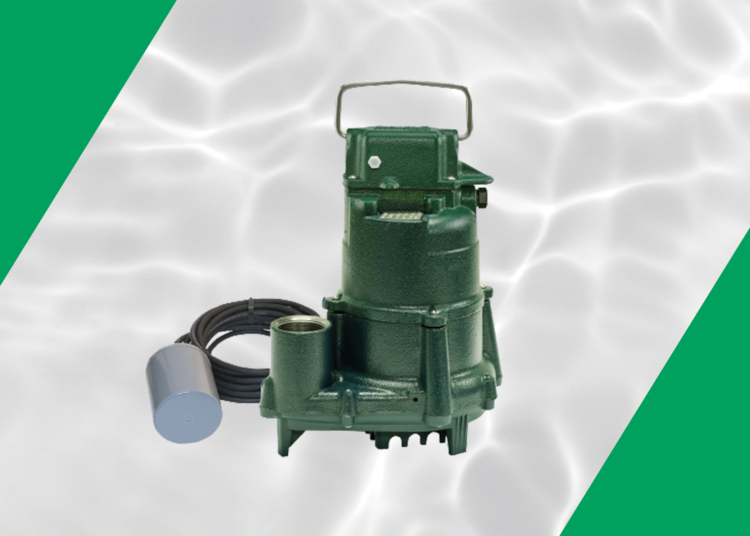Bathrooms are an essential part of any home, and having more than one can be a good idea for different reasons. However, it can be difficult to know where to add a new bathroom in your house, especially when you have to consider essential elements like plumbing.
Fortunately, with an upflush toilet system, you can add a bathroom anywhere in your house. Below, learn how these systems work and how they can help you easily create a new bathroom in your home.

THE VALUE OF ADDING A NEW BATHROOM
A fully remodeled bathroom can increase the resale value of your home by around 4%. Adding a new bathroom by converting existing space into an area with a sink, toilet, shower, or bath can increase your home’s value by an average of 5.7%. A new half bathroom will also increase your resale price, but not as much as adding a new full bathroom would.
The true value of a new bathroom for those who aren’t looking to sell any time soon is added functionality, accessibility, convenience, and comfort. Improve the layout of your home with a bathroom expansion.
THE COST OF ADDING A NEW BATHROOM
Many homeowners are hesitant to consider adding a new bathroom because they believe it costs too much money. Converting an existing space into a bathroom is more economically friendly than you might believe. Adding or remodeling a bathroom can yield a high return on investment when done correctly.
Depending on your project’s space, scope, and scale, the upfront investment can cost anything between $6,000 and $50,000. Converting an existing part of your house is the most affordable option, while creating a new space for a bathroom is the costliest option. Adding an entirely new area to your home just for a bathroom can cost you between $37,000 and $74,000.
An important cost that can often be overlooked is permit costs. The permits required to build a new bathroom vary based on where you live. Room additions, conversions, and electrical, mechanical, and plumbing work require permits. Ask a contractor or check with your local building department to find out what permits you’ll need for your project and how much they’ll cost.
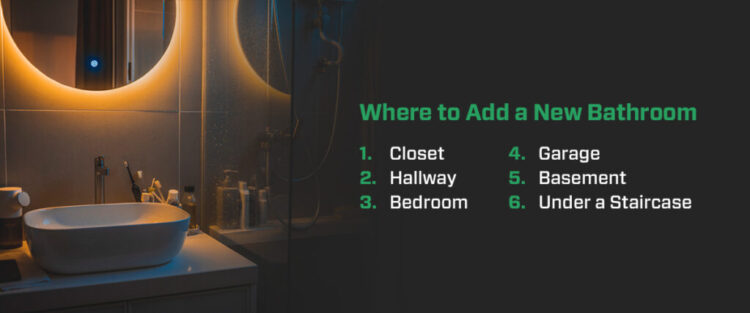
WHERE TO ADD A NEW BATHROOM
There are a lot of places in your home that could be the spot for your new bathroom. Here are several places to consider as you think about adding a new bathroom to your home:
1. Closet
Not having enough bathrooms can be more inconvenient than having too much closet space. Closets can take up a lot of prime real estate in your house, especially in houses with walk-in closets. Turning a roomy closet area into a small bathroom is an efficient way of upgrading your home and optimizing a potentially less helpful space.
Walk-in closets are easy to convert into a new bathroom. If you have around 25 square feet of space to work with, you can turn this storage area into a functional bathroom. Walk-in closets are usually found in bedrooms, so turning one into a bathroom effectively adds an ensuite feature to your house.
2. Hallway
Hallways often have plenty of space to use for a new bathroom. Hallway space is easy to manipulate and reshape into building the perfect half bathroom for your home. Depending on the layout of your home, you could be able to turn your hallway into a full guest bathroom.
If you decide to go the hallway route, you must ensure the space supports a bathroom. Plumbing, wiring, space, and ventilation are vital when planning your new bathroom. Call a professional to answer any questions about converting your hallway into a new bathroom.
3. Bedroom
Bedrooms are an incredibly popular spot for new bathroom installations. Adding an ensuite to the main bedroom is one option to increase functionality and boost resale value, or you may consider adding a bathroom to a spare room to make it a more comfortable place for guests to stay.
If you have a large bedroom, you might want to partition a section of it for your ensuite or convert a large walk-in closet into a private bathroom. A half bathroom can take up less space and can easily be worked into your room’s design.
In case you’re wondering, an ensuite doesn’t have to be that big. The smallest sized space you need for a fully functional ensuite bathroom is around 5 feet by just over 4 feet.
4. Garage
Most garages are designed to fit two cars. If you only have one car or don’t need that much space, then your garage could be the perfect spot for an extra bathroom. Because garages are built on ground level, they’re easy to connect to power and water systems.
The biggest potential drawback of having a bathroom in your garage is the ventilation. Garages don’t often have the best ventilation, so you might need to make some changes to accommodate for that. Adding a window is a simple fix for this problem and can prevent humidity and moisture from potentially damaging your walls.
5. Basement
The basement is another example of a great place for an extra bathroom. Basements can easily be turned into finished spaces the whole family can use. Adding a bathroom makes your basement a more functional part of your house and is an effective way to optimize unused space.
Basement bathrooms and garage bathrooms share a lot of similar issues. Bathrooms in these spaces are harder to ventilate and may require a fan or ventilation system. Any mistakes made during the installation could damage your home’s foundation, so professional installation is a must, and an upflush toilet system means you don’t need to break ground to install the bathroom.
6. Under a Staircase
There’s a surprising amount of space to work with underneath a staircase. So long as you have at least 25 square feet to work with, you can turn the space under your staircase into a full bathroom. If you don’t have that much room, you can convert the space under your stairs into a half bathroom easily.
The space under your staircase is highly accessible, making it an effective place for a centrally located bathroom in your home.
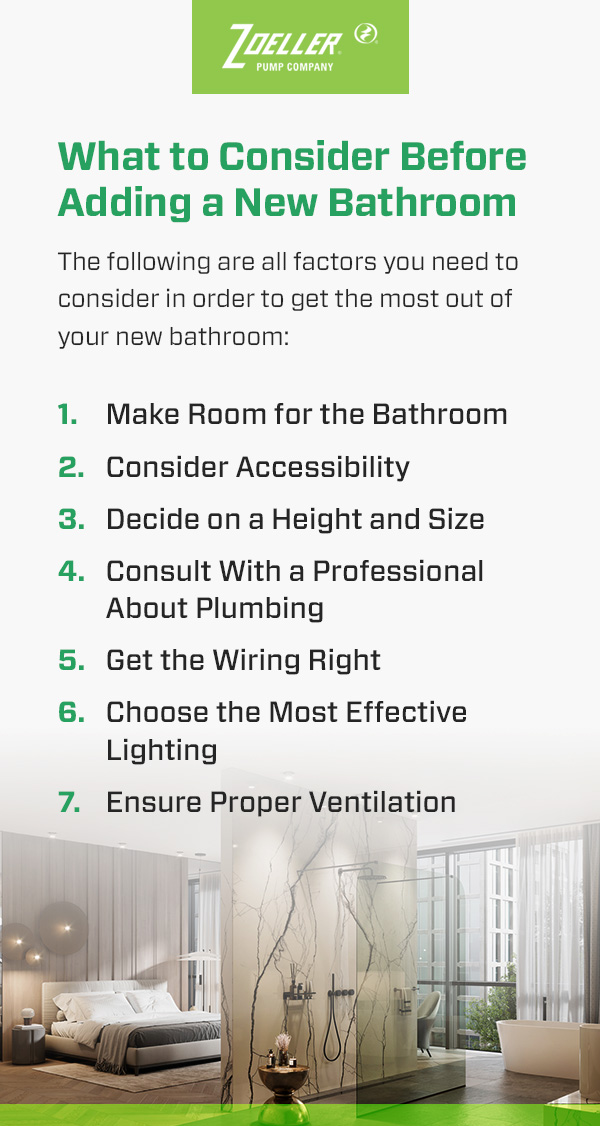
What to Consider Before Adding a New Bathroom
The best way for you to get the most out of this investment is to ask the right questions. Who’s your new bathroom for? How will it add value to your home? How can you get the most out of your space? These are some questions you should ask yourself before making any decisions.
The following are all factors you need to consider in order to get the most out of your new bathroom:
1. Make Room for the Bathroom
Even in the biggest homes, space is a precious commodity. Adding a new bathroom is about giving new life to under-utilized spaces in your house. That’s why it’s important to know where you want to put your new bathroom and how to make full use of the space. By knowing how much space you need, you can start looking for the perfect spot.
2. Consider Accessibility
Be sure to consider how accessible your bathroom will be when looking for the right spot for it. If it’ll be difficult for people to access, reconsider where you intend to install it. This factor is especially important to think about it if older adults or those with disabilities might be using the bathroom. Ensuring family and friends can easily find and use the bathroom is key.
3. Decide on a Height and Size
Plan out your bathroom down to the tiniest detail. This way, you’ll know exactly how much space you need to fit everything. You need to know the height, width, length, and area of the space. If a sharp corner will hinder your design, look elsewhere in your home for the perfect place.
Be 100% certain of your decisions and measurements before starting the project, so you don’t have to retrace your steps and make costly fixes.
4. Consult With a Professional About Plumbing
It’s strongly advised that you avoid using your exterior walls for plumbing and fixtures. Your pipes need to be aligned to accommodate everything your new bathroom needs and its layout. If you have limited plumbing knowledge, you need a plumber to help you plan out your piping.
The complexity of your house’s piping system will determine how much your plumbing costs will be. Using an upflush toilet system means you’ll spend less on altering plumbing and installing new pipes, which is a great idea for many new bathroom projects.
5. Get the Wiring Right
Supplying your bathroom with the right amount of power safely and efficiently is essential. Bathrooms that only utilize one outlet violate safety protocols, as you risk overloading the power in those spaces. Your plan must distribute the wiring evenly across multiple outlets. The size and location of your bathroom will affect its outlet accessibility and the amount of power it’ll need.
6. Choose the Most Effective Lighting
The right lighting can make or break a bathroom’s functionality. A dark bathroom is less inviting and useful than one that’s well-lit. However, too much light in a bathroom can be disorienting and waste power.
Mirror backlighting, overhead lighting, and wall lighting are the most effective ways of lighting up your bathroom. The shape and location of your bathroom will determine how many lights it needs.
7. Ensure Proper Ventilation
Moisture and bathrooms are a bad match, leading to mold, mildew, and lingering odors. That’s why it’s so important to properly ventilate your bathroom. The best way to avoid this problem is to ensure you install a fan that covers one cubic foot per minute per square foot of area in your room. A roof vent and fan with ducts will ensure your bathroom is always well-ventilated.

How an Upflush System Can Make Your Project Easier
An upflush toilet system, also known as a macerating toilet, is a unique type of toilet. Unlike a traditional toilet that drains the water down a 3- to 4-inch drain, an upflush toilet discharges out of the back into a pump tank with a macerator. The simplest way of adding a toilet to a new closet, basement, or hallway bathroom conversion is by using a macerating toilet, as they’re designed with placement flexibility in mind.
Because they’re designed differently, upflush toilets can help you turn any room in your home into a bathroom with these features:
- Save space: The most significant advantage of an upflush toilet system is its space-saving design. Regular toilets require access to the main plumbing system and a lot of space. An upflush toilet only requires minimal space for installation and can be installed almost anywhere.
- Easy installation: Upflush systems are much easier to install than traditional toilets, which require construction work and plumbing. To install an upflush toilet, you only need to connect the macerating unit and pump to the toilet bowl. Then, you run a pipe from the unit to your home’s main plumbing system. This process is convenient, simple, and can be done in a matter of hours.
This type of toilet is ideal for low-level bathrooms. Due to the lack of access to your home’s main plumbing, installing a traditional toilet in basements and lower-level parts of your home can be challenging. An upflush toilet system is ideally suited for these locations because of the way they’re designed and installed. If you’ve ever wanted to convert your basement area into a guest room, an upflush toilet might be the best way to achieve that goal.
Additionally, making changes to your home is often simpler when upflush toilets are involved. If you want to move your upflush toilet to a new location in your home, all you need to do is disconnect everything, move it to your new spot, and reconnect it. This flexibility makes renovating easier than ever before for homeowners.
Overall, installing an upflush toilet in your home can help you turn almost any space you want into a bathroom, all without needing to install additional plumbing or even break concrete to complete the project.
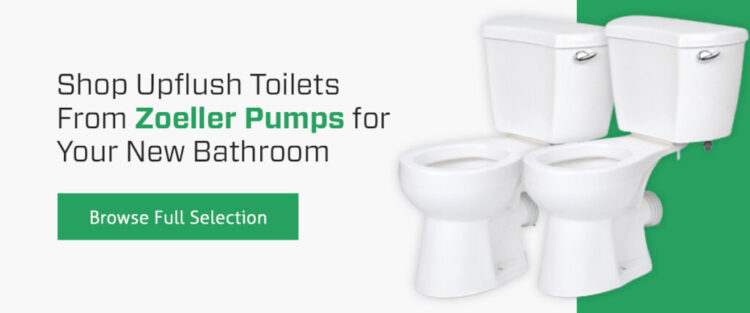
Shop Upflush Toilets From Zoeller Pumps for Your New Bathroom
Zoeller Pumps’ line of Qwik Jon® upflush toilet systems allows you to build your new bathroom anywhere you want. Whether you plan to add a new half bathroom under your staircase or wish to install a full bathroom to create an ensuite, using an upflush toilet system has endless benefits that make the construction process simpler and more affordable.
Browse the full selection of Qwik Jon® products in our online store now and find what you need to install the perfect bathroom anywhere you want. Reach out to us today at 800-928-7867 with questions.

